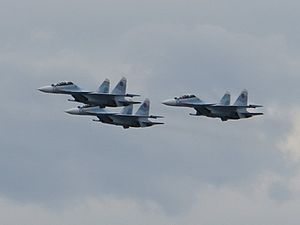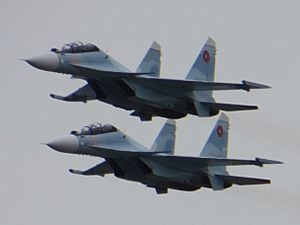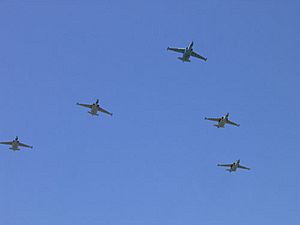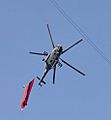Armenian Air Force facts for kids
Quick facts for kids Armenian Air Force |
|
|---|---|
|
|
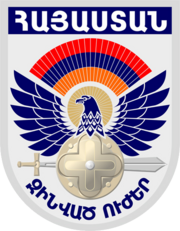
Armenian Armed Forces emblem
|
|
| Founded | 1992 |
| Country | |
| Type | Air force |
| Role | Aerial warfare |
| Size | 3,500 Personnel and 82 Aircraft |
| Part of | Armenian Armed Forces |
| Anniversaries | 26 June (Air Force Day) |
| Engagements |
|
| Insignia | |
| Roundel |  |
| Aircraft flown | |
| Attack | Su-25 |
| Fighter | Su-30 |
| Attack helicopter | Mi-8/Mi-24 |
| Trainer | L-39, Mi-2 |
| Transport | Il-76, Mi-8/Mi-17 |
The Armenian Air Force is the air part of the Armed Forces of Armenia. It was created in 1992 after the Soviet Union broke up. Its main job is to help Armenian soldiers on the ground. It does this by attacking targets from the air and carrying supplies in mountains.
The Air Force was very helpful during battles in the Nagorno-Karabakh region from 1992 to 1994. Since 2003, Armenia has been spending money to make its air fleet bigger and more modern. The Armenak Khanperyants Military Aviation University trains pilots for the Armenian Air Force.
Contents
History of the Armenian Air Force
How the Air Force Started
Armenia began taking over Soviet weapons after the USSR fell apart in 1991. However, its new air force did not start fighting until October 1992. The first Armenian combat loss happened on November 12, 1992. An Mi-24 helicopter was shot down while helping in a battle.
In January 1992, a new department for Aviation and Air Defense was created. This was part of Armenia's new Ministry of Defense. Later in 1992, the aviation part became its own separate group. This led to the creation of different aviation units.
Armenia got some aircraft from the former Soviet Union. This included three combat planes and at least 13 armed helicopters. These helicopters came from a Soviet regiment in 1991. The combat planes might have been a MiG-25 and two Su-25 jets.
Growing the Air Force
Conflicts with Azerbaijan in 1993–1994 led to a big growth in Armenia's air and air defense forces. Armenia focused a lot on making its Armenian Air Defense stronger. With help from Russia, Armenia quickly built a strong air defense system. This system used Soviet radars and surface-to-air missiles (SAMs). It was officially ready in April 1994.
By the end of 1994, the Armenian Air Force had more aircraft. This included 5–6 Su-25s and possibly one MiG-25. It also had trainer planes like the L-39 and Yak-52. For transport, it had planes like the An-2 and Tu-134. The helicopter fleet grew to include Mi-8/Mi-17 and Mi-24 helicopters.
The Air Force in the 21st Century
The Armenian Air Force grew and became more modern in 2004–2005. It bought ten Su-25 jets from Slovakia in 2004. These planes were delivered in 2005. Also in 2004, Armenia received L-39C trainers and Il-76 transport planes from Russia and Ukraine.
In 2016, Armenia discussed buying Su-30 fighter jets from Russia. Armenia ordered four Su-30SMs in February 2019. These planes arrived in December 2019. The country plans to get even more Su-30SM aircraft. However, the first four Su-30SMs were bought without missiles. This meant they could not be used in the 2020 Nagorno-Karabakh war.
How the Air Force is Organized
Not much public information is available about how the Armenian Air Force is set up. We know it works together with the Air Defense Force. In 2004, the Air Force had four main parts:
- 121st Ground Attack Aviation Squadron: This group is based at Gyumri.
- 15th Mixed Aviation Regiment: This is a helicopter group based at Yerevan.
- 60th Aviation Training Squadron: This is a training center at Arzni.
Airbases
Armenia's main airbases are at Erebuni Airport in Yerevan and Shirak Airport in Gyumri. There is also a training base at Arzni Airport.
Air Defense Force
The Air Defense Force is a part of the Armenian Air Force. It protects Armenia from air attacks. It has missile systems and anti-aircraft guns. These systems are mostly from the Soviet Union and Russia.
In 1992, the Air Defense Department was created. About 400 officers were trained for it. Light anti-aircraft units were also formed to protect ground troops.
Personnel and Training
In 1993, the Armenian Air Force had 2,000 people. By 2004, this number grew to 3,000. Armenia now trains its own military personnel. It has an aviation school in Yerevan.
Pilots and technical staff start their training at the Military Aviation Institute in Yerevan. This school was started in 1993. Pilot students learn to fly on planes like the Yak-52 and later on jet trainers like the L-39. This training happens at the airbase in Arzni. The base also has helicopters for training helicopter crews.
Working with Other Countries
Armenia and Russia's air and air defense forces work very closely. In 1995, Armenia signed a treaty with Russia. This allowed Russia to have a military presence in Armenia for 25 years. Russian air forces in Armenia include MiG-29 fighters at the Erebuni Airport near Yerevan.
The Armenian Air Force also takes part in yearly air defense exercises with the CSTO.
Commanders
- General Stepan Galstyan (2003-2009)
- Major General Avetik Muradyan (until March 2019)
Equipment
Aircraft
| Aircraft | Origin | Type | Version | In service | Notes |
|---|---|---|---|---|---|
| Combat aircraft | |||||
| Sukhoi Su-25 | Soviet Union | attack | Su-25K | 10 | |
| Sukhoi Su-30 | Russia | multirole | Su-30SM | 4 | |
| Transport | |||||
| Ilyushin Il-76 | Soviet Union | heavy transport | 2 | ||
| Combat helicopter | |||||
| Mil Mi-17 | Soviet Union | utility | Mi-8/17/171 | 11 | |
| Mil Mi-24 | Soviet Union | attack | 15 | ||
| Training aircraft/helicopters | |||||
| Aero L-39 Albatros | Czechoslovakia | jet trainer | 6 | ||
| Mil Mi-2 | Poland | helicopter trainer / utility | 3 | ||
| Sukhoi Su-25 | Soviet Union | jet trainer | 1 | ||
Air Defense Systems
| Name | Origin | Pictures | Type | Notes |
|---|---|---|---|---|
| SAM | ||||
| 2K11 Krug | Soviet Union |  |
mobile SAM system | |
| 2K12 Kub | Soviet Union | 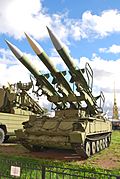 |
mobile SAM system | |
| 9K33 Osa | Soviet Union |  |
mobile SAM system | |
| 9k35 Strela-10 | Soviet Union |  |
mobile SAM system | |
| 9K37 Buk-M2 | Soviet Union |  |
mobile SAM system | |
| S-125 Neva | Soviet Union |  |
mobile SAM system | Upgraded versions are used. |
| S-300PM | Soviet Union |  |
mobile SAM system | 2-3 units |
| Air defence artillery | ||||
| ZSU-23-4 | Soviet Union | mobile anti-aircraft gun | Self-propelled anti-aircraft gun | |
| Space Systems | ||||
| Transponder-5 | Armenia, Spain | earth observation Satellite | Launched in Florida on May 26, 2022. It helps guard borders. | |
Incidents
- On November 4, 2008, an Armenian Air Force Mi-24 helicopter crashed during a training flight.
- On November 12, 2014, an Armenian Mil Mi-24 helicopter was shot down.
- On May 15, 2017, an Armenian air defense system was damaged by Azerbaijani forces.
- On December 4, 2018, an Armenian Air Force Su-25UBK training jet crashed.
- On September 29, 2020, during a conflict, an Armenian Su-25 was reportedly shot down.
Images for kids
See also
 In Spanish: Fuerza Aérea Armenia para niños
In Spanish: Fuerza Aérea Armenia para niños
- Armenian Army
- Military history of Armenia
- 1958 C-130 shootdown incident


